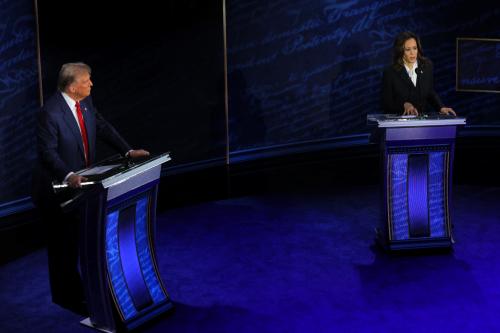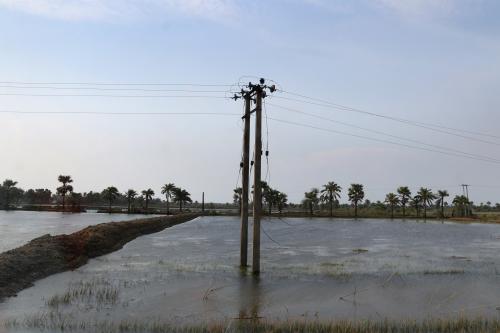Chairman Kim Jong-il’s lengthy three-week trip to Russia had its share of oddities: the world rarely gets to peek so openly at the seemingly strange activities of this last and most iconic of Stalinist rulers. But by focusing on the oddities, much of the world missed some of the more substantive results of the Kim-Putin summit. Unfortunately, the old-style communist idiosyncrasies parallel a discouraging return to old style North Korean diplomacy. This does not bode well for progress on the Korean peninsula.
Of course, the trip was full of Stalinist-style traditions and personal peculiarities. Taking ten days to travel across Russia in an armored train, only to disrupt rail traffic upon his arrival in Moscow, Kim the younger took obvious pride in following in the footsteps of his father’s trips to the Soviet Union during a much different era. There was the obligatory stop at one of Russia’s hulking state-owned defense factories, another nod to the bygone trappings of Soviet might. And, the homage by Kim Jong-il at the tomb of the Soviet Union’s founder, Lenin, only further underlined the trip’s out-of-step and bizarre character.
Perhaps oddest of all to outside observers, the North Korean press was replete with the usual rapturous glorification of the trip: the official North Korea news agency reported several “natural wonders” occurring while Kim was away—such as spontaneous fountains arising from lakes and brilliant double rainbows arching over Kim family monuments. The whole trip was oddly reminiscent not only of Kim Il-sung’s Cold War visits, but also of Mao Zedong’s famed two-month trip to Moscow in early 1950, where he sought Soviet support to face an increasingly troubling security situation.
But while such eccentricities gained most of the headlines, the trip also resulted in substantive policy directions. At the top of the list is the joint statement to emerge from Kim’s visit—the so-called Moscow Declaration. Three points stand out in the statement. First, the two sides reconfirmed their cooperative ties and called for the establishment of a fairer world system based on the principles of equality, mutual respect and mutual benefit, language reminiscent of the Chinese “Five Principles of Peaceful Coexistence.” In this regard, the importance of the United Nations was underscored.
Second, the two sides also reaffirmed their support for the Anti-Ballistic Missile Treaty as the “cornerstone of strategic stability and the basis for further strategic offensive arms reductions.” Third, the joint statement included the assurance that Pyongyang’s missile program has a “peaceful character” and “presents no danger” to any country which treats North Korean sovereignty with respect.
In addition to the joint statement, the North Korean regime issued signals which also point to a hardening of positions in Pyongyang. Upon Kim’s return to Pyongyang on August 18, the official Nodong Shinmun stated there would be no further talks with the Washington as long as North Korea missiles were a part of the discussion. Perhaps most importantly, the publicly available record of the Moscow talks give no indication of whether the North Korean leader has any intention to make good on his pledge to travel to Seoul for a reprise of the historical June 2000 summit with Kim Dae-jung in Pyongyang. Indeed, to the contrary, the best the Russian side could offer publicly was an official hope to see reunification, and that Russia would not interfere in this process.
True, on the up side, Putin’s assurance that the North Korean leader planned to maintain the moratorium on missile testing through 2003 is to be welcomed. Also, the proposal for Russia to build a rail line through North Korea to link both North and South to the trans-Siberian railway would, if realized, have important commercial and political potential for stability on the peninsula. But overall, the visit to Moscow and the statements to emerge from it indicate a troubling turn away from the promise of the year 2000 – marked by the Kim-Kim summit and the visit of U.S. Secretary of State Albright to Pyongyang—and an unfortunate return to the shortsighted North Korean tactics of years past.
This approach is characterized by high-level diplomacy between Kim and other major power centers with interests on the peninsula—such as Europe, Russia, China and smaller American allies such as Australia and Canada—and the studious avoidance of discussions with the most critical partners, South Korea and the United States. Having achieved about all they dare to with Seoul or Washington, Pyongyang will extract summitry, political prestige and commercial concessions from other world leaders in the hopes of leveraging further advantages from the South and from the United States over time. Such tactics have worked in the past. But with the Bush administration in power, and the Kim Dae-jung presidency on the wane, it is not so clear such tactics can work as well this time. In any event, far from signaling new breakthroughs, Kim’s Moscow visit—both for its oddities and its substance—indicate a drift back to business as usual in Pyongyang.



Commentary
Op-edInternational Diplomacy
September 5, 2001